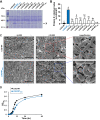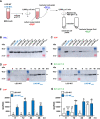Ribosome-Engineered Lacticaseibacillus rhamnosus Strain GG Exhibits Cell Surface Glyceraldehyde-3-Phosphate Dehydrogenase Accumulation and Enhanced Adhesion to Human Colonic Mucin
- PMID: 32801170
- PMCID: PMC7531950
- DOI: 10.1128/AEM.01448-20
Ribosome-Engineered Lacticaseibacillus rhamnosus Strain GG Exhibits Cell Surface Glyceraldehyde-3-Phosphate Dehydrogenase Accumulation and Enhanced Adhesion to Human Colonic Mucin
Abstract
Differences in individual host responses have emerged as an issue regarding the health benefits of probiotics. Here, we applied ribosome engineering (RE) technology, developed in an actinomycete study, to Lacticaseibacillus rhamnosus GG (LGG). RE can effectively enhance microbial potential by using antibiotics to induce spontaneous mutations in the ribosome and/or RNA polymerase. In this study, we identified eight types of streptomycin resistance mutations in the LGG rpsL gene, which encodes ribosomal protein S12. Notably, LGG harboring the K56N mutant (LGG-MTK56N) expressed high levels of glyceraldehyde-3-phosphate dehydrogenase (GAPDH) on the cell surface compared with the LGG wild type (LGG-WT). GAPDH plays a key role in colonic mucin adhesion. Indeed, LGG-MTK56N significantly increased type A human colonic mucin adhesion compared to LGG-WT in experiments using the Biacore system. The ability to adhere to the colon is an important property of probiotics; thus, these results suggest that RE is an effective breeding strategy for probiotic lactic acid bacteria.IMPORTANCE We sought to apply ribosome engineering (RE) to probiotic lactic acid bacteria and to verify RE's impact. Here, we showed that one mutant of RE Lacticaseibacillus rhamnosus GG (LGG-MTK56N) bore a GAPDH on the cell surface; the GAPDH was exported via an ABC transporter. Compared to the wild-type parent, LGG-MTK56N adhered more strongly to human colonic mucin and exhibited a distinct cell size and shape. These findings demonstrate that RE in LGG-MTK56N yielded dramatic changes in protein synthesis, protein transport, and cell morphology and affected adherence to human colonic mucin.
Keywords: GAPDH; Lacticaseibacillus rhamnosus GG; human colonic mucin; ribosome engineering.
Copyright © 2020 Ishida et al.
Figures




Similar articles
-
Introduction of Spontaneous Mutations Using Streptomycin as a Method for Lactic Acid Bacteria Breeding.Methods Mol Biol. 2024;2851:15-21. doi: 10.1007/978-1-0716-4096-8_2. Methods Mol Biol. 2024. PMID: 39210168
-
Transcriptional Response and Enhanced Intestinal Adhesion Ability of Lactobacillus rhamnosus GG after Acid Stress.J Microbiol Biotechnol. 2018 Oct 28;28(10):1604-1613. doi: 10.4014/jmb.1807.07033. J Microbiol Biotechnol. 2018. PMID: 30196592
-
Generation of Lactose- and Protease-Positive Probiotic Lacticaseibacillus rhamnosus GG by Conjugation with Lactococcus lactis NCDO 712.Appl Environ Microbiol. 2021 Feb 26;87(6):e02957-20. doi: 10.1128/AEM.02957-20. Print 2021 Feb 26. Appl Environ Microbiol. 2021. PMID: 33419737 Free PMC article.
-
Adaptation factors of the probiotic Lactobacillus rhamnosus GG.Benef Microbes. 2010 Nov;1(4):335-42. doi: 10.3920/BM2010.0032. Benef Microbes. 2010. PMID: 21831772 Review.
-
Thirty Years of Lactobacillus rhamnosus GG: A Review.J Clin Gastroenterol. 2019 Mar;53 Suppl 1:S1-S41. doi: 10.1097/MCG.0000000000001170. J Clin Gastroenterol. 2019. PMID: 30741841 Review.
Cited by
-
Development of an intestinal epithelial cell line and organoids derived from the same swine and characterization of their antiviral responses.Biosci Microbiota Food Health. 2024;43(4):342-351. doi: 10.12938/bmfh.2024-0046. Epub 2024 May 28. Biosci Microbiota Food Health. 2024. PMID: 39364127 Free PMC article.
-
Development of fluorescence-labeled antibody for immune checkpoint inhibitor using engineered probiotics.AMB Express. 2023 Jan 12;13(1):4. doi: 10.1186/s13568-023-01509-y. AMB Express. 2023. PMID: 36635518 Free PMC article.
-
Glyceraldehyde-3-Phosphate Dehydrogenase Increases the Adhesion of Lactobacillus reuteri to Host Mucin to Enhance Probiotic Effects.Int J Mol Sci. 2020 Dec 21;21(24):9756. doi: 10.3390/ijms21249756. Int J Mol Sci. 2020. PMID: 33371288 Free PMC article.
-
Sharing of Moonlighting Proteins Mediates the Symbiotic Relationship among Intestinal Commensals.Appl Environ Microbiol. 2023 Mar 29;89(3):e0219022. doi: 10.1128/aem.02190-22. Epub 2023 Feb 27. Appl Environ Microbiol. 2023. PMID: 36847513 Free PMC article.
References
-
- Zheng J, Wittouck S, Salvetti E, Franz C, Harris HMB, Mattarelli P, O'Toole PW, Pot B, Vandamme P, Walter J, Watanabe K, Wuyts S, Felis GE, Ganzle MG, Lebeer S. 2020. A taxonomic note on the genus Lactobacillus: description of 23 novel genera, emended description of the genus Lactobacillus Beijerinck 1901, and union of Lactobacillaceae and Leuconostocaceae. Int J Syst Evol Microbiol 70:2782–2858. doi:10.1099/ijsem.0.004107. - DOI - PubMed
Publication types
MeSH terms
Substances
LinkOut - more resources
Full Text Sources
Molecular Biology Databases
Research Materials

